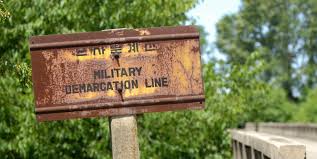From Brinksmanship to Bargain: the Two Koreas Avoid War

How the “adults in the room” avoided a crisis spiralling out of control.
In the days following the latest intra-Korean episode of brinksmanship that unfolded in late August, varying interpretations of why crisis escalation was avoided have been offered by each side. Both Koreas projected tough postures prior to and during their negotiations which were conducted at the border village of Panmunjom. While North Korean leader Kim Jong-un has since called the 25 August inter-Korean agreement to end a military standoff a ‘landmark occasion’, he attributed the strength of his own country’s armed forces as the key to avoiding further crisis escalation. South Korean President Park Gyun-hye likewise adopted a tough stance during the crisis. She demanded nothing less than an inconceivable formal North Korean apology for what she viewed as dire North Korean provocations leading to the crisis: the placing of landmines in the Demilitarized Zone (DMZ) separating the two Koreas, which resulted in the detonation of a landmine and the maiming of two South Korean soldiers (North Korea denied responsibility). Park also held fast when the North Korean military shelled propaganda loudspeakers that Seoul had activated in response to that incident.
Respected analysts evaluating the crisis after its de-escalation have argued that North Korea never really intended to attack targets in the South. It may be that the doubling of North Korean force levels manning artillery positions close to the DMZ and the dispatch of North Korean submarines to undetected positions, even as North Korean officials were talking with their South Korean counterparts during a marathon three-day session, were nothing more than pressure tactics to win concessions from the Park government. At the time, however, tensions were clearly intensifying and, at least for a while, prospects for wider clashes between the North and South seemed very real. Kim Jong-un’s youth and inexperience in crisis management added uncertainty to what was a genuine concern for those who worried about the risks of inter-Korean miscalculation leading to greater crisis escalation.
This was clearly a situation tailor-made for clear-headed and coherent diplomacy. Both sides dispatched their most experienced negotiators to engage in what proved to be lengthy talks necessary to achieve crisis resolution. South Korean lead negotiator Kim Kwan-jin has a long track record of performing successfully under fire. Previously Chairman of South Korea’s Joint Chiefs of Staff, Kim has since served as both Park’s and her successor, Lee Myung-bak’s, National Defence Minister before moving to his present position as Chief of South Korea’s National Security Office. His North Korean negotiating counterpart, Marshal Hwang Pyong-so, is widely considered to be North Korea’s second most powerful official after Kim Jong-un, is Vice Chairman of his country’s National Defence Commission, and is a wily political operator within the treacherous echelons of North Korean politics. Seoul’s Minister of Unification, Hong Yong-pyo, faced off with a long-standing North Korean cross-border relations expert, Kim Yong-gon, to complete the four-person assemblage. This particular grouping clearly epitomized both sides’ military hierarchies and reflected their determination to go beyond negotiating a crisis resolution to discuss wider inter-Korean relations.
Unlike many past inter-Korean bargaining sessions, these talks were businesslike and devoid of North Korean histrionics. North Korea’s immediate objective was to win Seoul’s acquiescence to turn off the loudspeakers that were blaring anti-Kim Jong-un messages into border areas occupied by North Korean troops susceptible to disillusionment and defection. Once this affront to the North Korean leadership’s ‘dignity’ was removed, the North finessed a statement of ‘regret’ for the two injured South Korean soldiers and talked about other issues. These included reunions of families separated by the Korean War, non-governmental exchanges in cultural and sporting sectors, and other low-key confidence-building measures. Indeed, such steps were specifically designated in a six-point joint communique released at the conclusion of the negotiations.
The take-away from this latest episode of inter-Korean brinkmanship is that neither Pyongyang nor Seoul have an interest in fighting a new Korean War, but that saving national face is a powerful factor to be confronted whenever initial incidents (usually precipitated by North Korean probes to test South Korean will) lead to crisis intensification. The South Korean government struck an effective balance between standing firm in response to North Korean provocations and tactics of intimidation, while avoiding disproportionate reactions which could have led the crisis to spin out of control. It is notable that the brief suspension of the United States’ and South Korean military exercises allowed both allies’ commanders time to work out a sensibly-crafted set of warnings and signals to the North Koreans. Ultimately, the ‘adults in the room’ representing both sides prevailed over those in both countries who may have been pressing for greater confrontation.
William T. Tow is Professor, Department of International Relations, School of International, Political & Strategic Studies at the ANU College of Asia and the Pacific. This article can be republished with attribution under a Creative Commons Licence.


